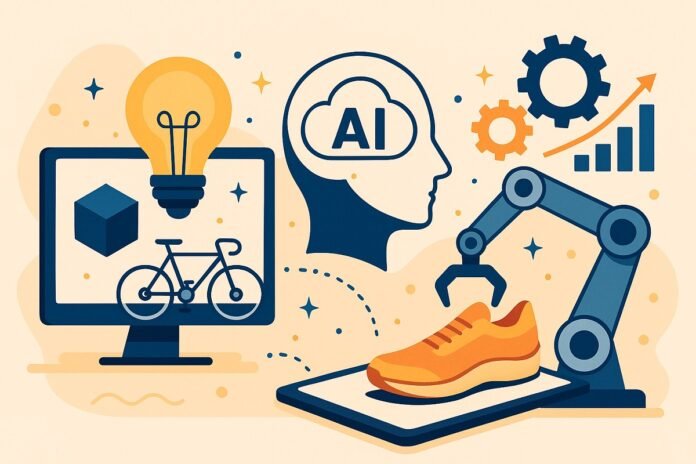Never before have businesses needed more innovation, faster and smarter design processes than today. Generative AI tools are changing how products are designed, bringing products to market, and, with it, the shape of product development as we know it.
These systems of cognition are far more than mere automation. They rely on large data sets and deep learning algorithms and creative algorithms to generate ideas and simulate performance, and in some cases, even to optimize performance, all without human bias and fatigue.
The attempt has been misguided for years, and there are now countless tech startups and industrial behemoths relying on AI-driven tools to develop faster and better quality products, as well as to explore the edges of experimental design in ways never imagined a few years ago.
How Generative AI Tools Are Revolutionizing Product Development
Indeed, we are witnessing not only a digital transformation in the production industry but also a change in the very nature of the production processes. Let’s examine how generative AI will impact every step of the product development chain and what it implies for corporations, innovators, and users.
#1. Enhance Your Product Design Concepts with AI creativity.
Among the most controversial aspects of generative AI is its application in conceptual design. “By looking at how things are designed today, and at consumer preferences, and at technical constraints, AI models can come up with an entirely new idea for what a product should be,” he says.
It is not just a collection of random ideas, but they are data-proven insights that allow designers to avoid the beginning of the idea generation process. AI as a Fermi Paradox. The works of AI creativity, however, might serve as inspirations for human designers, by exposing creative possibilities they may not have otherwise imagined, and by speeding up the innovatory process.
Also Read: How AI Can Help Discover Innovation Ideas That Often Go Ignored
#2. Automating Prototyping and Design Iterations
Generators using machine learning could cut prototyping times by orders of magnitude. Simply put, various research activities and tests are carried out not manually, but by means of intelligent electronic tools that develop numerous designs, spot possible shortcomings, and even give a verdict on which ones among them are most promisingly efficient.
This means that it takes less time to make the leap from an to end occluded toxicology, let alone the advantage of today’s artificial intelligence. On the other side of the spectrum, auto-generating and optimizing designs, in the case of industrial machinery or digital products, can help companies reduce time to market and resource needs.
#3. Improving the User Experience with Predictive Modelling
AI not only helps build better products; it helps build better experiences. Tools of generative artificial intelligence, combined with predictive analytics, can forecast how users can interact with the product.
From interface behavior in apps to ergonomics of consumer electronics, AI can dig into oceans of behavioral data and suggest features that suit the user. That results in products that are as functional as they are innately user-friendly from the start.
Also Read: 10 Best Uses of Generative AI Consulting Services to Supercharge Business
#4. Speeding Up Time-to-Market
Timing is of the essence in fast-growing industries. AI-generated instruments reduce product development times by eliminating the need for manual work. Working on tasks such as CADs, efficiency testing, or even technical docs, that can now be automated somewhat or even fully.
This increased velocity enables one of the first players in a category to get their product to market, gain share, and outpace competitors who are still employing traditional product development cycles.
#5. Reducing Costs and Material Waste
One underappreciated dimension of generative AI is what it can achieve for cost control and the environment. AI models can simulate various manufacturing modes to test efficiency and suggest what design tweaks may let you pare down materials without losing quality.
This is of special use in applications in aerospace, automotive, and consumer applications, which require expensive disposal of waste material. The result is options where companies can not only save money, but also meet environmental and sustainability programs.
Also Read: How a Generative AI Can Skyrocket Your Business Growth!
#6. Fostering Collaboration Between Teams
AI-powered platforms often function in the cloud, which enables various cross-functional teams like design, engineering, marketing, or manufacturing to operate synchronously.
Thus, every portion of the organization can support similar design iterations, trial findings, market research, and customer feedback by using the same AI system. This minimizes blocks and misunderstandings and also allows for a smoother overall path of product development from concept to launch.
Conclusion
The generative AI tool is no longer a future experiment – it is a fundamental enabler of next-generation product design. The influence of AI on product innovation is substantial – it inspires fresh ideas, accelerates design cycles, lowers expenses, and overall leads to higher user satisfaction.
Businesses using generative AI today aren’t just building better products — they’re future-proofing the entire product development cycle. As this technology continues to mature, it will continue to change the product game, and it will become essential for any company looking to keep up in an ever-competitive market.

